|
Given that it was written 28 years before Bram Stoker's seminal Dracula, it's surprising how long it took the film world to really embrace Sheridan Le Fanu's 1871 vampire novella Carmilla. Then again, maybe not. After all, the element of the story that really distinguishes it from Stoker's is that the vampire is a woman. A woman who has a taste for other women. As you can imagine, even a suggestion of lesbianism in the cinema of countries as sexually repressed as Britain and America were back in the day (oh, we've really come such a long way) would result in scandal, court cases, and the immediate banning of the film in question. Thus, when Carl Theordor Dreyer adapted elements of the story for his gorgeous 1932 Vampyr, one particular aspect was conspicuous by its absence. Not that a film as rich as Vampyr needed it of course. Yeah, let's go with that.
In 1960, Roger Vadim gave the novella a go in Et mourir de plaisir [Blood and Roses] and did pretty damned well by it, and in 1964 Christopher Lee starred in a reasonably faithful Italian adaptation, La cripta e l'incubo [Crypt of the Vampire], which was directed by Camillo Mastrocinque whilst masquerading as someone called Thomas Miller. Intriguingly, one of (if not the) first cinematic suggestion of lesbian vampires can be found not in 1960s European cinema, but in a Hollywood film made in 1936. You read that right. If you're a fan of the genre and you've not seen Universal's Dracula's Daughter then you'd do well to hunt it out. It's a solid vampire movie in its own right, and even today stands up by taking a different tack to its male-driven brethren. And there's a scene in there that, while far from explicit (it's Hays Code era America folks!), is still suggestive enough to give the impression that the censors were either blind, stupid or secretly rather excited.
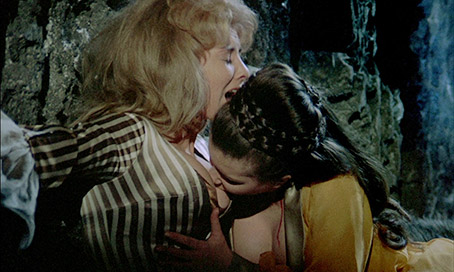
But it was 1970 before British horror specialists Hammer Films was able to squeeze a lesbian themed vampire movie past chief censor John Trevelyan, who'd warned them in advance not to push their luck. No surprise, then, that the inspiration for The Vampire Lovers was a certain novella by Sheridan Le Fanu. It's actually an unexpectedly faithful adaptation, though I have a feeling that being true to its literary source was not the prime motivator for the film's production. The film did well enough to quickly spawn two follow-ups, Lust for a Vampire and Twins of Evil (both 1971), and the three films became known as the Karnstein Trilogy.
Although also inspired by Camilla, Twins of Evil bears only a passing resemblance to the novella. It opens as a gaggle of puritan witch-finders, led by a skull-faced Peter Cushing, head out on horseback at night to do God's work. I disliked this lot from the moment I laid eyes on them. They ride up to the homestead of a Norfolk woodcutter (I'm going by the accent and the axe in his hand), knock the fellow out and strap his pretty young girlfriend to a cross and burn her for being a witch. No evidence is offered, no trial is convened – she's just accused, convicted and executed on the word of these demented idiots. And this all takes place before the main titles.
We're then introduced to Maria and Frieda, a pair of recently orphaned teenage twins who have travelled from Venice to Karnstein to live with their Aunt Cathy and their Uncle Gustav. After giving them a pep talk about dressing just a wee bit more soberly, Aunt Cathy is about to show them their room when Uncle Gustav arrives home from a night of witch burning. Yes, these pretty young Venetians with their gay bonnets and low necklines are lodging with the single most intolerant religious nutbag in central Europe.
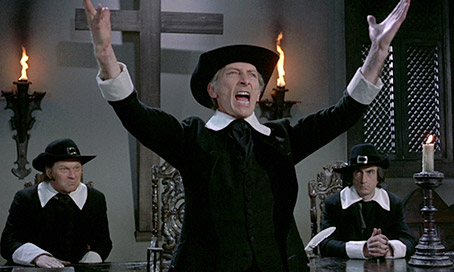
Now despite my characteristically flippant tone, I should say up front that all of this is handled with impressive confidence and filmic economy. It's the scene that follows that I always have a little trouble with, although through absolutely no fault of this film or its makers. As the Brotherhood meet to discuss whom they should execute next, Gustav whips them up into enough of a frenzy to have them screaming for a burning. And if you know your Monty Python, it's hard not to smile. Such is the curse of memorable mockery. Just as a close friend of mine cannot now watch the ending of The Planet of the Apes without recalling Homer Simpson's hilarious recreation of it from Deep Space Homer, the sight and sound of these men wildly screaming "Burn her!" en masse too readily recalls a favourite scene from Monty Python and the Holy Grail ("What do we burn apart from witches?" "More witches!"). But if you put this aside, it's a scary sequence, with a young girl marked for death in a matter of seconds by dangerous men in positions of authority. And for what? For failing to take a husband, or being too pretty, or not saying her prayers three times a day. No doubt about it, Gustav Weil is a nasty piece of work. Just as well we're not asked to see him as a good guy. Ah, wait a minute...
You see in some ways it turns out that he's actually right. There is an evil at large, but a witch it is not. You can tell what it is by the impossibly positioned holes they find on the neck of one of its victims. And burning this particular evil at the stake will apparently do no good (I beg to differ, but...). To kill a vampire, at least if you're going to stop its essence assuming another form, you have to cut off its head or ram a stake through its cold, black heart. Gustaf doesn't accept this until late in the game, when it's hammered home to him by Anton, a schoolteacher who regards Gustav's beliefs as dangerous superstition (I liked him immediately). Anton's the nearest the film has to a regular hero. For a short while I did warm to hedonistic playboy Count Karnstein, who is able to loudly mock Gustav's beliefs to his face because he is under the protection of the Emperor. But when he bores of the satanic ritual being staged for his amusement, he kills the peasant girl the performers have procured for their theatrics as a sacrifice to Satan. Her blood revives the ghost of Karnstein's distant ancestor Countess Mircalla, who assumes solid form and gives the Count a snog before biting him and transforming him into a vampire.
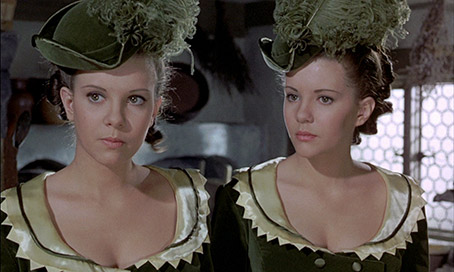
But what of the pretty Maria and Frieda we met at the start? Well identical though they may be in appearance, in terms of their personalities they're worlds apart. Maria is the nice girl, the one who apologises to Gustav and hangs her head when he admonishes them both for their disrespectful appearance. Frieda, on the other hand, has a taste for adventure and responds to Gustav's angry reference to the fourth commandment with a defiant, "Which one is that?" You can imagine his response. As soon as Frieda hears about the wicked Count Karnstein she's eager to meet him, and in no time at all is sneaking out at night to visit him at his castle. As you might expect, Frieda's nocturnal adventures see her seduced by the dark side, and soon she's sporting the sort of fangs that have Gustav baying for her blood. It's unfortunate, then, that Maria has been successfully pretending to be Frieda to cover for her sister's absence in the twilight hours.
Plot wise, this is largely standard Hammer fare, with an innocent threatened by a dastardly villain, and her friends and family charged with saving her soul. Anton is cast as the voice of reason, but almost powerless against the blind and lethal bigotry of Gustav and the Brotherhood. It's thus a little galling when he later has to engage their help to free Maria from Karnstein's clutches. They're not even consistent in their wrongdoing. At one point a girl is saved from burning after she does not shrink from a crucifix held in front of her, but in that pre-title killing, the girl in question is wearing a crucifix around her neck, and Gustav just tears it off and sets fire to her anyway.
It's nice to see Cushing in a role in which he puts his commanding authority to unlikeable use, and there are a couple of pleasant surprises in the supporting roles, notably Isobel Black's low key performance as Anton's sister Ingrid, and the lovely Dennis Price, who is sorely underused as Karnstein's sycophantic assistant Dietrich. Of course, the principal draw here is the casting of real life twins Mary and Madeleine Collinson as Maria and Frieda, two bewitchingly pretty girls whose previous claim to fame was that they had posed nude together in Playboy. As it happens they do rather well here, playing (but not overplaying) their roles as good girl and rebel distinctly enough for us to be able to tell them apart (it'd be bloody tough otherwise). As Count Karnstein, Damien Thomas does tend to play to the back of the gallery, but he is rather fun, and it's he who provides the film with its only unintentional laugh. Late in the story his mute manservant Joachim tries to warn him of the approach of the Brotherhood by miming the weapons they are carrying, only to have the increasingly outraged Karnstein just stand there and translate each one of the mimes for us in turn. "They have crosses? ... And stakes? ... And AXES?"
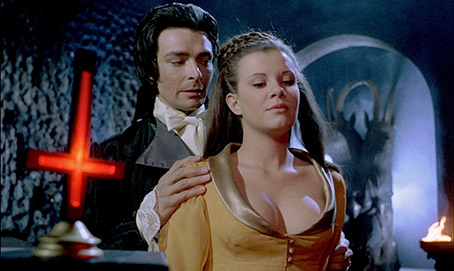
Tightly directed by John Hough, who went on to do a belter of a job two years later with The Legend of Hell House, the film frequently looks rather lovely, thanks largely to some luminous colour cinematography by the talented Dick Bush (whose other work includes Blood on Satan's Claw, Mahler and the gloriously shot Tommy). It's late season Hammer doing what it did best; retelling an old story with a handful of new variations and with style and pace. And for a Hammer film the special effects are surprisingly good. A mirror trick involving both twins is visible due to the timing of their movements being slightly off, but an earlier one involving Karnstein and Mircalla is convincing enough for me to wonder how it was done. And there's a beheading with a sword here that's as good as any I've seen in pre-digital age horror, one whose effect is achieved almost solely through smart camera placement and editing. Now that's filmmaking.
Framed in its original aspect ratio of 1.66:1, initial impressions are very impressive, with a consistently punchy but not over-aggressive contrast range and the sort of crispness and visible detail that prompts us to choose Blu-ray over DVD. There are faint traces of digital noise reduction in the subdued grain and slight smoothing of facial detail, but this is not visible at normal viewing distance. Many sequences have an earthy hue, but when the brighter colours appear they are strikingly rendered. The image is also spotless and free of damage.
The Linear PCM mono soundtrack has the expected treble leaning and lack of bass response, but there's no denying the clarity, and the absence of damage and background hiss or hum is pleasing. There are a couple of places when the dialogue becomes just a little fluffy, but this lasts only a couple of lines in each case.
UK Trailer (2:21)
A rather well assembled windowboxed trailer that pushes Damien Thomas as "Hammer's new master of the macabre". New, perhaps, but also short-lived – as far as I'm aware, this is the only Hammer film he appeared in.
US Trailers and Promos (6:12)
A similar trailer to the above (much of it is identical), but with the narration delivered by an American voice, is followed by a trailer for a double-bill run with Hands of the Ripper, plus three TV spots that describe the girls as "the most fearsome females in horror history." A bit strong.
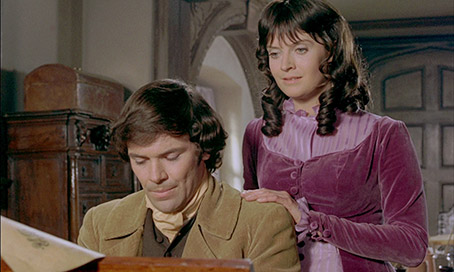
Deleted Scene (1:09)
Anton plays a song of his own composition titled True Love, which is sung by two of the girls from his class in a manner that suggests they've just come back from a holiday in the 1960s.
Production Image Gallery (11:06)
A lengthy rolling gallery of promotional stills, some colour, some black-and-white. Good quality, but could have been larger.
Behind the Scenes Image Gallery (3:03)
Altogether more interesting, as these show director Hough and the crew at work. There a few posed photos here too, especially of the twins, plus a few of them in their underwear and even without clothing. I say.
Portrait Image Gallery (1:51)
Pretty much what it claims to be. The twins feature heavily here.
Promotional Image Gallery (2:54)
A rather splendid gallery of posters and promotional material, a few of them from foreign parts.
Commemorative Booklet
This was not supplied with the review disc, so I cannot comment on it.
Not top drawer Hammer, but better than I remember, the film does sometimes feel like a mishmash of ideas (witch-hunters vs. vampires?), but is executed with confidence and a fair amount of style. Network's Blu-ray is in solid shape and the extras aren't bad, though do pale a little compared with those on the company's simultaneously released Blu-ray of Countess Dracula. For Hammer Horror aficionados, definitely recommended.
|